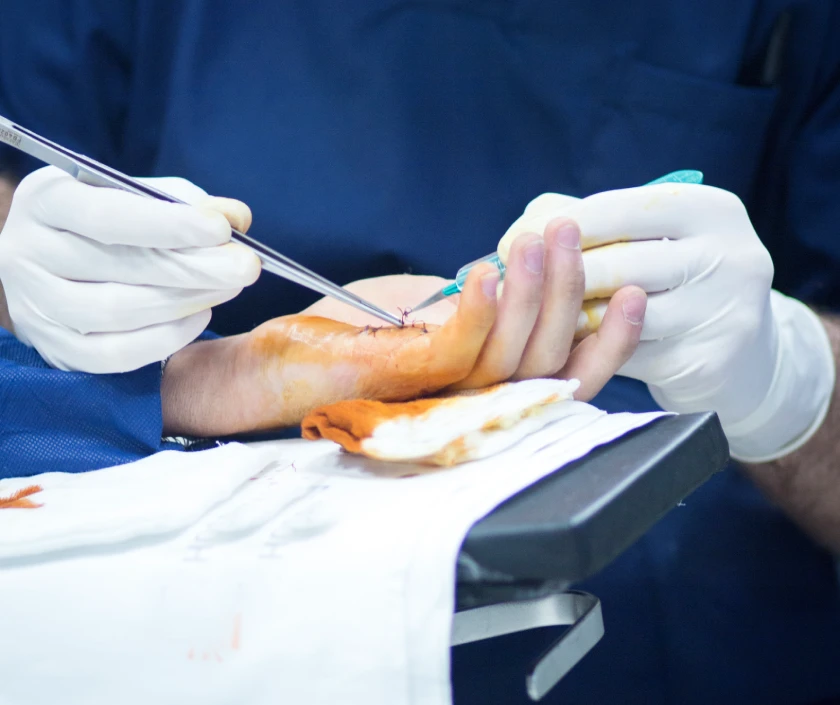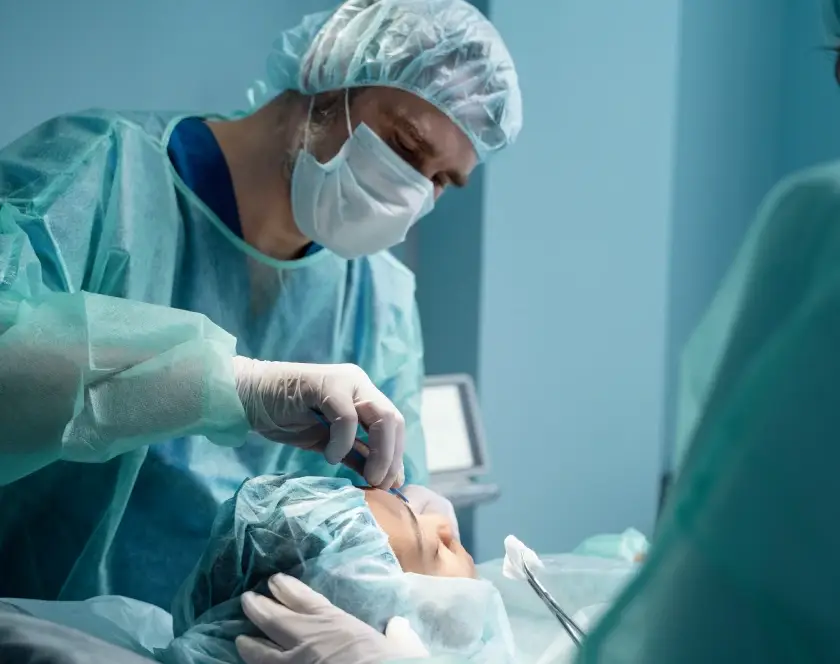What Is Trauma Reconstruction?
Trauma reconstruction is a specialized branch of reconstructive plastic surgery focused on restoring function and appearance after severe injuries. It involves repairing damage from accidents or injuries such as finger degloving injuries, crush injuries, soft tissue loss, tendon tears, fractures, and nerve or vascular damage. At Elegance Clinic, our surgeons use advanced microsurgical techniques to rebuild tissues, improve limb function, and help patients return to daily activities with confidence.
When Is Trauma Reconstruction Recommended?
Trauma reconstruction is recommended when injuries are so severe that simple wound closure or basic first aid is not enough. You may need this treatment if you have:
- Crush injuries with significant tissue damage
- Degloving injuries, where skin and soft tissue are peeled away from underlying structures
- Tendon injuries or Achilles tendon rupture, causing loss of movement
- Open fractures of the hand or foot
- Severe soft tissue loss exposing bone or vital structures
- Complex wounds requiring skin debridement surgery or wound debridement surgery
- Vascular injuries causing compromised blood flow
- Nerve injuries with loss of sensation or function
Types of Trauma Reconstruction Performed at Elegance Clinic
At Elegance Clinic, we provide comprehensive care for:
- Crush Injury – reconstruction after high‑impact accidents
- Degloving Injury Management – covering exposed tissues with flaps or grafts
- Tendon Repair Surgery – restoring movement in injured fingers, hands, or feet
- Tendo Achillis Rupture – surgical repair for torn Achilles tendon
- Soft Tissue Loss – reconstruction using skin grafts or flaps
- Debridement (Wound/Skin Debridement Surgery) – removing dead tissue to promote healing
- Skin Loss Reconstruction – skin grafting for burns or avulsion injuries
- Hand Fracture Reconstruction – aligning and stabilizing broken bones
- Vascular Repair – restoring blood supply through microsurgery
- Nerve Repair – microsurgical techniques to regain sensation and motor function
What Happens Before This Treatment?
Before planning trauma reconstruction, our surgeons perform a thorough assessment. You may need:
- X‑rays, CT scans, or MRI to evaluate bone, tendon, and nerve injuries
- Blood tests to check for infection or healing capacity
- Cleaning and stabilization of the wound
Temporary splints or dressings before definitive surgery
Our team will explain the surgical options, risks, and expected outcomes during pre‑operative counseling.
How Does Trauma Reconstruction Work?
The exact surgical approach depends on the type of injury. In general:
- Damaged or dead tissue is removed through wound debridement surgery
- Broken bones are stabilized with plates, screws, or wires
- Tendon repair surgery or nerve repair is performed using microsurgical techniques
- Skin and soft tissue defects are covered using skin grafts or local/regional flaps
- Vascular repair may be done to restore circulation in severely injured areas
How Long Does This Treatment Take?
Surgery duration varies based on complexity:
- Simple debridement may take 30–60 minutes
- Complex reconstructions, such as degloving injury management or combined tendon and vascular repair, can take several hours.
Your surgeon will provide an estimate depending on your case.
Risks and Benefits of Trauma Reconstruction
Benefits:
- Restores function of injured limbs
- Prevents infections and complications
- Improves cosmetic appearance and mobility
- Reduces long‑term disability
Risks:
- Infection or wound healing delays
- Scar formation
- Need for additional surgeries in complex cases
- Rare complications like reduced sensation or stiffness
Post‑Treatment Care
- Keep the surgical area clean and dry as advised
- Take prescribed antibiotics and pain medication
- Attend regular follow‑up visits for dressing changes and physiotherapy
- Protect the reconstructed area from strain or injury during recovery
What Can I Expect for Recovery?
Recovery depends on the severity of injury and type of reconstruction performed:
- Minor procedures may heal in a few weeks
- Complex cases like crush injuries treatment or tendon repairs may require months of physiotherapy and rehabilitation
Your care team will guide you through exercises, splinting, or occupational therapy to regain maximum function.
When to Consult a Doctor for Trauma Reconstruction?
Seek immediate medical attention if you experience:
- Severe open injuries with exposed bone or tendon
- Finger degloving injury or tissue avulsion
- Non‑healing wounds despite basic care
- Numbness, loss of movement, or discoloration in fingers or toes after injury
- Signs of infection such as fever, redness, or foul discharge
At Elegance Clinic, our trauma reconstruction team is dedicated to helping you regain both function and quality of life after an injury.
If you or your loved one needs expert care for crush injuries, degloving injuries, tendon repair surgery, soft tissue loss, or advanced wound management, book a consultation with our specialists today.
Hear from our patients
EXCELLENTTrustindex verifies that the original source of the review is Google. Dr.shah is very kind and understanding... during my surgery of xentholesma..sir didn't late me feel nervous at all..he kept talking to me..he kept singing classic old hindi songs while performing surgery..I was like "ye to apne type ka banda hai"..I didn't even realise when my surgery got over. mr. Bhargav in staff and other team members were very kind an supportive.. I just have one minor complaint..simple panipuri wala or vegetable person in surat is always ready to receive online,UPI ,QR payment..but,pharmacist over their always be like "mera to cash payment hoga". Rest all is good.. people over there are very sincere at their work. I would definitely suggest to visit elegance clinic for getting your xentholesma cured.treatment charges are also affordable.Posted onTrustindex verifies that the original source of the review is Google. I am fully satisfied my hydrafacial treatmentPosted onTrustindex verifies that the original source of the review is Google. The experience was too good staff was really humble and the results were actually good!Posted onTrustindex verifies that the original source of the review is Google. I got hair transplant which is very painful but Got it done on ELEGANCE so it was very normal and which was bery helpful for me Special thanks to staff.Posted onTrustindex verifies that the original source of the review is Google. I had PRP and laser treatments at Elegance clinic for my skin and hair, and the experience has been truly excellent. Dr. Krina handled my skin treatment with great care and attention — I noticed a visible improvement in my skin texture and glow. For my hair, Dr. Bhargav and Dr. Ashutosh guided me through the PRP sessions with patience and professionalism, ensuring I was comfortable and well-informed throughout. The entire staff is polite, supportive, and the clinic maintains high standards of hygiene and advanced equipment. Overall, I’m very satisfied with the results and would highly recommend this hospital to anyone looking for genuine care and effective treatmPosted onTrustindex verifies that the original source of the review is Google. Dr Asutosh sir is very excellent Tammy tack sargary..Posted onTrustindex verifies that the original source of the review is Google. A good doctor clinic review often highlights a clinic's positive aspects, such as a doctor's expertise, a friendly and competent staff, convenient hours, and a clean, comfortable environment.Posted onTrustindex verifies that the original source of the review is Google. After suffering a serious burn injury due to a machine accident, I was fortunate to be treated by Dr. Ashutosh Shah at Elegance Clinic. His skill and calm approach gave me confidence from the first consultation. The surgery was done with great care, and the recovery support was outstanding. The clinic is clean and peaceful, and the staff treats you like family. Forever thankful for their help during a very tough timePosted onTrustindex verifies that the original source of the review is Google. One of the best doctors as well as staff in the town, just loved the process post surgery, follow up calls is non negotiable for them. Dr ashutosh shah and dr chetan were incredible. Best service provided by the elegance clinic!Posted onTrustindex verifies that the original source of the review is Google. "We had a wonderful experience at Elegance Clinic for my wife's HIFU treatment. The staff was friendly and supportive, and the clinic environment was very professional. Dr. Ashutosh Shah took the time to explain the procedure and what to expect. The final result is excellent—my wife's skin looks much firmer and rejuvenated. She is very happy, which makes me happy! A truly world-class clinic for aesthetic procedures
Contact Us
Ready to discuss? Fill out our contact form for a confidential consultation.
FAQ
What is trauma reconstruction surgery?
Trauma reconstruction is a type of plastic surgery performed to repair and restore function after severe injuries like crush injuries, degloving injuries, tendon tears, or soft tissue loss. It involves procedures such as wound debridement, tendon or nerve repair, and skin grafting.
What types of injuries are treated with trauma reconstruction?
At Elegance Clinic, we treat:
- Crush injuries
- Degloving injuries
- Tendon repair and Tendo Achillis rupture
- Soft tissue loss or skin loss
- Hand fractures
- Vascular and nerve injuries
- Complex wounds needing skin debridement surgery or wound debridement surgery.
Will I regain full function after trauma reconstruction?
Many patients regain excellent function with proper surgery and rehabilitation. However, outcomes depend on the extent of the original injury, the tissues involved, and how well you follow your post‑treatment plan.







